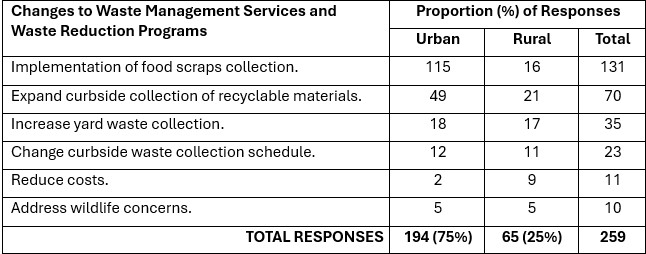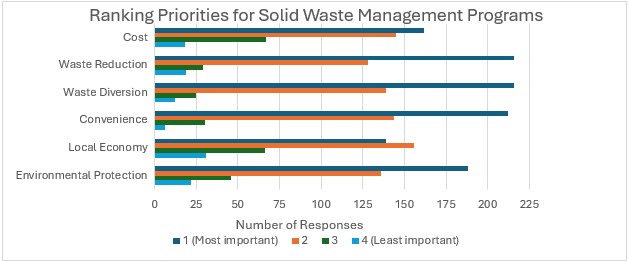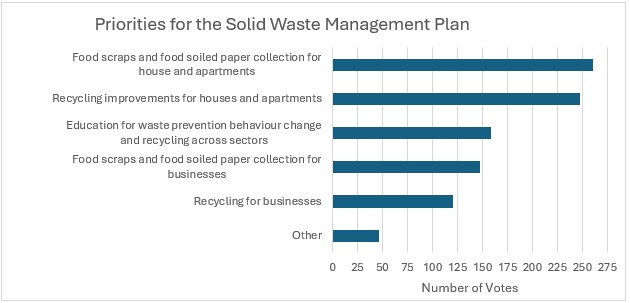Survey Results
Thank you to everyone who participated in the Regional Solid Waste Management Plan (SWMP) survey. Your feedback is helping shape how solid waste will be managed across the RDOS for the next decade. Nearly 400 residents shared their priorities and ideas, providing valuable insight into what matters most to RDOS communities. Below are some of the key findings from the survey.
Nearly 400 residents from across the RDOS shared their input, with 72% from urban areas and 28% from rural areas.
Over 90% of respondents are satisfied with curbside collection for garbage, recycling, and yard waste.
- One-third of respondents want food scraps collection.
- Over 15% want expanded curbside recycling (e.g., glass, plastic bags, Styrofoam).
- Nearly 10% want more frequent or extended yard waste collection.
Waste diversion, waste reduction, convenience, environmental protection, and cost.
Residents ranked residential waste diversion programs as a higher priority than programs for businesses and institutions.
The Regional District of Okanagan-Similkameen (RDOS) is updating the Regional Solid Waste Management Plan (SWMP). This will replace the previous SWMP that was adopted in 2012. As part of the planning process, the RDOS conducted an online survey to gain public input on how solid waste should be managed in the region for the next decade.
The survey closed on February 28, 2025. Highlights of the survey results include:
- Nearly 400 responses were collected and analyzed. Representing residents from across the region:
- 72% from urban areas (municipalities)
- 28% from rural areas (Electoral Areas)
- Most respondents live in single-family homes, but many housing types were represented in the responses.

- Respondents were “satisfied” or “very satisfied” with existing solid waste services:
- Over 90% said they were “very satisfied” or “satisfied” with their curbside collection services for garbage, recyclables and yard waste.
- Satisfaction with current waste management facilities ranged from 50% to 95% with most facilities receiving over 80% satisfaction ratings.
- Respondents expressed interest in the following changes to solid waste management in the RDOS:
- A third of respondents would like to see the implementation of food scraps collection.
- Some residents identified concerns with program costs, human-wildlife conflicts and potential contamination.
- Over 15% of respondents want to see curbside recycling programs expanded to include more materials such as glass, more plastic (such as bags and wrappers) and Styrofoam.
- Almost 10% of respondents identified wanting more frequent yard waste collection or to expand the collection season.

- A third of respondents would like to see the implementation of food scraps collection.
- Respondents throughout the RDOS ranked their priorities for assessing solid waste management programs as:
- Waste Diversion
- Waste Reduction
- Convenience
- Environmental Protection
- Cost

- Responses indicate that residential waste diversion programs are a higher priority for RDOS residents than programs targeting businesses and institutions.

The number and diversity of responses to the survey provide RDOS with valuable insight into the priorities and preferences of residents throughout the region. The survey results were shared with the SWMP Public Advisory Committee and Technical Advisory Committee and continue to influence the development of the updated regional SWMP.
RDOS SWMP Overview as presented to the RDOS Board on December 5, 2024, is available here from 2:11 to 2:33 (22 minutes).
RDOS SWMP Overview
Project Updates
Thank you to everyone who participated in the Regional Solid Waste Management Plan (SWMP) survey.
Your feedback is helping shape how solid waste will be managed across the RDOS for the next decade. Nearly 400 residents shared their priorities and ideas, providing valuable insight into what matters most to RDOS communities. Below are some of the key findings from the survey.
The Regional District of Okanagan-Similkameen (RDOS) is updating the Regional Solid Waste Management Plan (SWMP). This will replace the previous SWMP that was adopted in 2012. As part of the planning process, the RDOS conducted an online survey to gain public input on how solid waste should be managed in the region for the next decade.
The survey closed on February 28, 2025. Highlights of the survey results include:
- Nearly 400 responses were collected and analyzed. Representing residents from across the region:
- 72% from urban areas (municipalities)
- 28% from rural areas (Electoral Areas)
- Most respondents live in single-family homes, but many housing types were represented in the responses.

- Respondents were “satisfied” or “very satisfied” with existing solid waste services:
- Over 90% said they were “very satisfied” or “satisfied” with their curbside collection services for garbage, recyclables and yard waste.
- Satisfaction with current waste management facilities ranged from 50% to 95% with most facilities receiving over 80% satisfaction ratings.
- Respondents expressed interest in the following changes to solid waste management in the RDOS:
- A third of respondents would like to see the implementation of food scraps collection.
- Some residents identified concerns with program costs, human-wildlife conflicts and potential contamination.
- Over 15% of respondents want to see curbside recycling programs expanded to include more materials such as glass, more plastic (such as bags and wrappers) and Styrofoam.
- Almost 10% of respondents identified wanting more frequent yard waste collection or to expand the collection season.

- A third of respondents would like to see the implementation of food scraps collection.
- Respondents throughout the RDOS ranked their priorities for assessing solid waste management programs as:
- Waste Diversion
- Waste Reduction
- Convenience
- Environmental Protection
- Cost

- Responses indicate that residential waste diversion programs are a higher priority for RDOS residents than programs targeting businesses and institutions.

The number and diversity of responses to the survey provide RDOS with valuable insight into the priorities and preferences of residents throughout the region. The survey results were shared with the SWMP Public Advisory Committee and Technical Advisory Committee and continue to influence the development of the updated regional SWMP.
Solid Waste Management Plan Review
The Regional District of Okanagan-Similkameen (RDOS) is updating its Solid Waste Management Plan (SWMP) and wants your input on how solid waste is managed in the region over the next decade. The SWMP reflects a long-term vision for how the RDOS will manage solid waste. Once approved by the Ministry of Environment and Parks, the new plan will replace the previous 2012 SWMP.
Why do we need a SWMP?
- In this region, approximately 585 kilograms of garbage per person per year went to RDOS landfills. This adds up to approximately 53,000 metric tonnes per year. This amount of garbage is the equivalent of over 10,000 curbside garbage truck trips.
- Reducing garbage generation will help to manage costs over time, meet residents’ recycling and composting expectations, align with provincial and federal policies, protect the environment, and reduce greenhouse gas emissions.
- More than 65% of what is thrown away as garbage can be diverted from landfills (recycled or composted).
As part of the Let’s Talk Less Trash consultation process, the SWMP survey will gather feedback on current and future recycling and garbage services. The survey results will be presented to the Public Advisory Committee (PAC) and Technical Advisory Committee (TAC) for consideration. The survey is scheduled to run through the end of February 2025. Participants can enter to win one of five $100 gift cards. A second round of public engagement will take place later in 2025 after options have been developed.
The RDOS SWMP will focus on the five "R"s of the pollution prevention hierarchy as a tool to evaluate and prioritize future improvements: reduce, reuse, recycle (and compost), recover, and residual management.
The RDOS is currently looking at the following issues as priority considerations:
- Optimize disposal efficiency across the Solid Waste system – conduct waste disposal analysis with financial, environmental, and social considerations in mind
- Seek ways to prevent waste in the first place – enhance waste prevention education and behaviour change programs, improve reuse, repair and share infrastructure and systems, and support a circular economy approach
- Increase reuse and diversion opportunities across sectors for single-family (SF), multi-family (MF) and industrial, commercial and institutional (ICI) through infrastructure, services, programs, and policies.
- Organics
- Recycling
- Construction and Demolition (C&D) waste prevention/diversion
Solid Waste Management Plan Review
The Regional District of Okanagan-Similkameen (RDOS) is reviewing the Solid Waste Management Plan (SWMP). SWMP reflects a long-term vision for how each regional district manages solid waste, including diversion and disposal.
The current plan was adopted in 2012 after approval from the Ministry of Environment and Parks. The new plan will set the legal framework for how waste, recycling, and waste reduction is managed, evaluate how the systems are working and recommend areas of improvement.
The RDOS SWMP will focus on the five "R"s of the pollution prevention hierarchy as a tool to evaluate and prioritize future improvements: Reduce, Reuse, Recycle, Recover, and Residuals Management.
The RDOS is in search of dedicated individuals to form the Public Advisory Committee (PAC) to provide advice and input in the development of the SWMP. The RDOS is currently looking at the following issues as priority considerations:
- Optimize Disposal Efficiency Across the Solid Waste System – conduct waste disposal analysis with financial, environmental, and social considerations in mind
- Seek Ways to Prevent Waste in the First Place – enhance waste prevention education and behaviour change programs, improve reuse, repair and share infrastructure and systems, and support a circular economy approach
- Increase Reuse and Diversion Opportunities Across Sector for Single Family (SF), Multi-Family (MF) and Industrial, Commercial and Institutional (ICI) through infrastructure, services, programs, and policies
- Organics
- Recycling
- Construction and Demolition (C&D) waste prevention/diversion
A key component of the review will be consultation with the public and Indigenous communities. The RDOS seeks PAC members from diverse locations within the South Okanagan. All voices matter in shaping the waste management strategy for the region over the next decade.
Send your suggestions and comments to solidwaste@rdos.bc.ca.
The Terms of Reference and Application Form for the Public Advisory Committee can be viewed in the Documents section of this page.
Please refer to this page for updates and details of forthcoming events and surveys that will seek input from the community.







